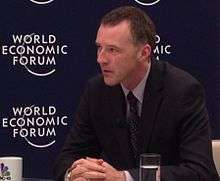Wim Sweldens
Wim Sweldens is a Belgian American business leader notable for innovations in communications and signal processing technology. He developed algorithms for compressing three dimensional images[1] into billions of tiny triangular modules.[2] At telecommunications firm Alcatel-Lucent in New Jersey, he led development of new cell tower technology called lightRadio which reduces the size of transmission equipment dramatically.[3] The equipment uses only basic electrical power and can be placed indoors and linked to optical fiber cables;[4] it enables mobile networks to operate with much less electricity, halving CO2 emissions and reducing the carbon footprint,[5] and permitting cell phone service to reach more people over expanded geographic areas.[6] The technology may mean the end of cell towers within ten years, according to several reports.[7]
Wim Sweldens | |
|---|---|
 Sweldens speaking at the World Economic Forum in 2012 | |
| Education | University of Leuven, Belgium |
| Occupation | Scientist, Telecom innovator |
| Employer | Kiswe Mobile |
| Known for | data compression |
References
- Peter Schröder, Wim Sweldens (May 1995). "Geek Page - Wavelet Image Compression: Beating the bandwidth bottleneck". Wired. Retrieved 2012-01-25.
- LEE DYE (September 11, 2000). "A Leap for High-Speed Transmission: Data: Latest technology will lessen image process time. 3-D capacity could prove boon for industries". Los Angeles Times. Retrieved 2012-01-25.
- Ben Rooney (February 7, 2011). "Alcatel-Lucent Shrinks Cell Tower". The Wall Street Journal: Technology. Retrieved 2012-01-25.
- Associated Press (February 12, 2011). "Wireless advances could mean no more cell towers". USA Today. Retrieved 2012-01-25.
- Nick Wood (7 February 2011). "Alcatel-Lucent signals 'end of base station'". Total Telecom. Retrieved 2012-01-25.
- Charles Arthur (7 February 2011). "Tiny device could transform mobile communications, says its creator". The Guardian. Retrieved 2012-01-25.
- Peter Svensson (Associated Press) (February 12, 2011). "Advances could mean no more cell towers". The News-Herald. Retrieved 2012-01-25.
External links
- Wim Sweldens at lightRadio press conference (see 3:00+ minutes)
- Research website